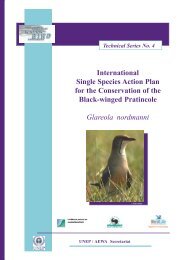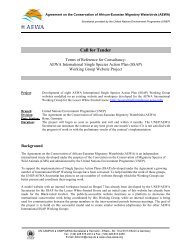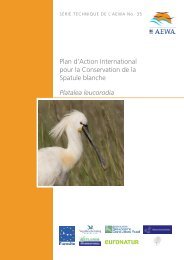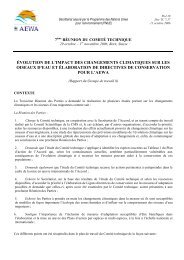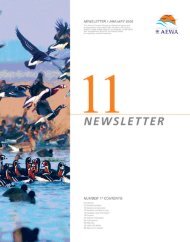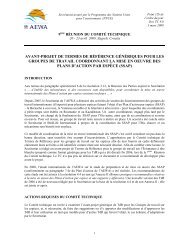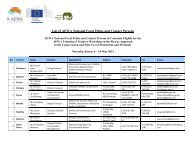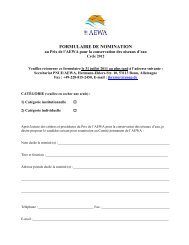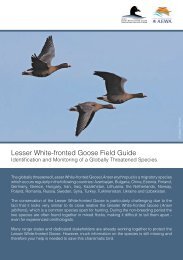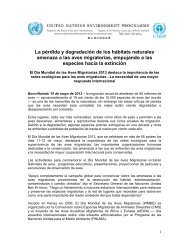International Single Species Action Plan for the ... - AEWA
International Single Species Action Plan for the ... - AEWA
International Single Species Action Plan for the ... - AEWA
Create successful ePaper yourself
Turn your PDF publications into a flip-book with our unique Google optimized e-Paper software.
<strong>AEWA</strong> Technical Series No. 36 - Annexes<br />
Germany (EU)<br />
Vernacular name: Zwerggans<br />
The species regularly passes through Germany in small numbers. Since 1990, 30-100<br />
observations of Lesser White-fronted Geese have been reported annually. The great majority<br />
of birds were observed in <strong>the</strong> nor<strong>the</strong>rn part of Germany. Important sites are listed in Section<br />
4.4. Birds of <strong>the</strong> wild Fennoscandian population tagged with satellite transmitters have been<br />
recorded in Mecklenburg-Vorpommern and Brandenburg during autumn migration<br />
(Lorentsen et al. 1998, Aarvak & Øien 2003). At most German sites, Lesser White-fronted<br />
Geese are observed in <strong>the</strong> company of Greater White-fronted Geese Anser albifrons and are<br />
thought most likely to belong to one of <strong>the</strong> wild populations. Data indicate that birds from<br />
more than one subpopulation migrate through Germany, with some individuals of <strong>the</strong> Western<br />
main population also wintering, especially in Brandenburg, Sachsen, Sachsen-Anhalt and<br />
Nordrhein-Westfalen (Mooij & Heinicke in prep.). Birds from <strong>the</strong> Swedish<br />
supplementation/reintroduction programme, typically associating with Barnacle Geese, have<br />
been recorded increasingly frequently in Niedersachsen and Schleswig-Holstein (a total of 29<br />
individuals was recorded in mid-November 1999; van den Bergh 2000), and <strong>the</strong>re is a handful<br />
records <strong>for</strong> Brandenburg and Mecklenburg-Vorpommern. There is one record of a bird from<br />
<strong>the</strong> Finnish reintroduction project in Mecklenburg-Vorpommern (Mooij & Heinicke in prep).<br />
Under <strong>the</strong> title of ‘Operation Lesser White-fronted Goose’ (Aktion Zwerggans) a programme<br />
is currently being developed to lead supplemented/reintroduced birds, using microlight<br />
aircraft, from a <strong>for</strong>mer breeding site in Swedish Lapland to a traditional wintering area in <strong>the</strong><br />
Lower Rhine area of Nordrhein-Westfalen.<br />
The species is fully protected in Germany but Greater White-fronted Geese are still hunted in<br />
places and both species occur in mixed groups (Lorentsen et al., 1998).<br />
Greece (EU)<br />
Vernacular name: Nanochina (transliteration)<br />
The LWfG arrive in Greece by late October to early November and depart by early to mid<br />
March. Lake Kerkini, Lake Ismarida (also known as Lake Mitrikou) and <strong>the</strong> Evros Delta (all<br />
listed as Special Protection Areas, Ramsar Sites and Important Bird Areas) are key staging<br />
and wintering sites <strong>for</strong> <strong>the</strong> Fennoscandian population. Nestos Delta (also listed as Special<br />
Protection Area, Ramsar Site and Important Bird Area) is also a wintering site with less<br />
regular sightings. Though 1,630 birds were counted in <strong>the</strong> Evros Delta in 1963 (Handrinos<br />
1991), numbers are now far lower. Between 1980 and 1990 counts varied between 30 and 150<br />
individuals (Aarvak et al., 1996, 1997), while a maximum of 71 individuals (<strong>for</strong> Lake<br />
Kerkini, Lake Ismarida and <strong>the</strong> Evros Delta combined) was recorded in <strong>the</strong> winter of<br />
1998/1999 (Lorentsen et al. 1999). More recently, a maximum of 52 LWfGs were seen at<br />
Lake Kerkini in November 2005 (T. Naziridis/LIFE-Nature project, reported on<br />
http://www.piskulka.net/).<br />
52 Lesser White-fronted Geese were recorded using <strong>the</strong> saltmarshes around <strong>the</strong> Drana Lagoon<br />
in <strong>the</strong> Evros Delta of north-east Greece, in early January 2004. One of <strong>the</strong>se birds had been<br />
colour-ringed in nor<strong>the</strong>rn Norway in May 2004 (Vangeluwe, 2004). This indication that <strong>the</strong><br />
Evros Delta is a key wintering area <strong>for</strong> <strong>the</strong> wild Fennoscandian population was confirmed<br />
when eight Lesser White-fronts ringed at <strong>the</strong> Valdak Marshes (Norway) were seen in <strong>the</strong><br />
Evros Delta in January 2005 (D. Vangeluwe per T. Aarvak, pers. comm.). Between<br />
November 2005 and January 2006, up to 40 Lesser White-fronts were seen in <strong>the</strong> same area<br />
of <strong>the</strong> Evros Delta as in 2005. At least five of <strong>the</strong>se birds carried colour rings (Y. Tsougrakis<br />
<strong>International</strong> <strong>Single</strong> <strong>Species</strong> <strong>Action</strong> <strong>Plan</strong> Lesser White-fronted Goose –Annexes<br />
X



